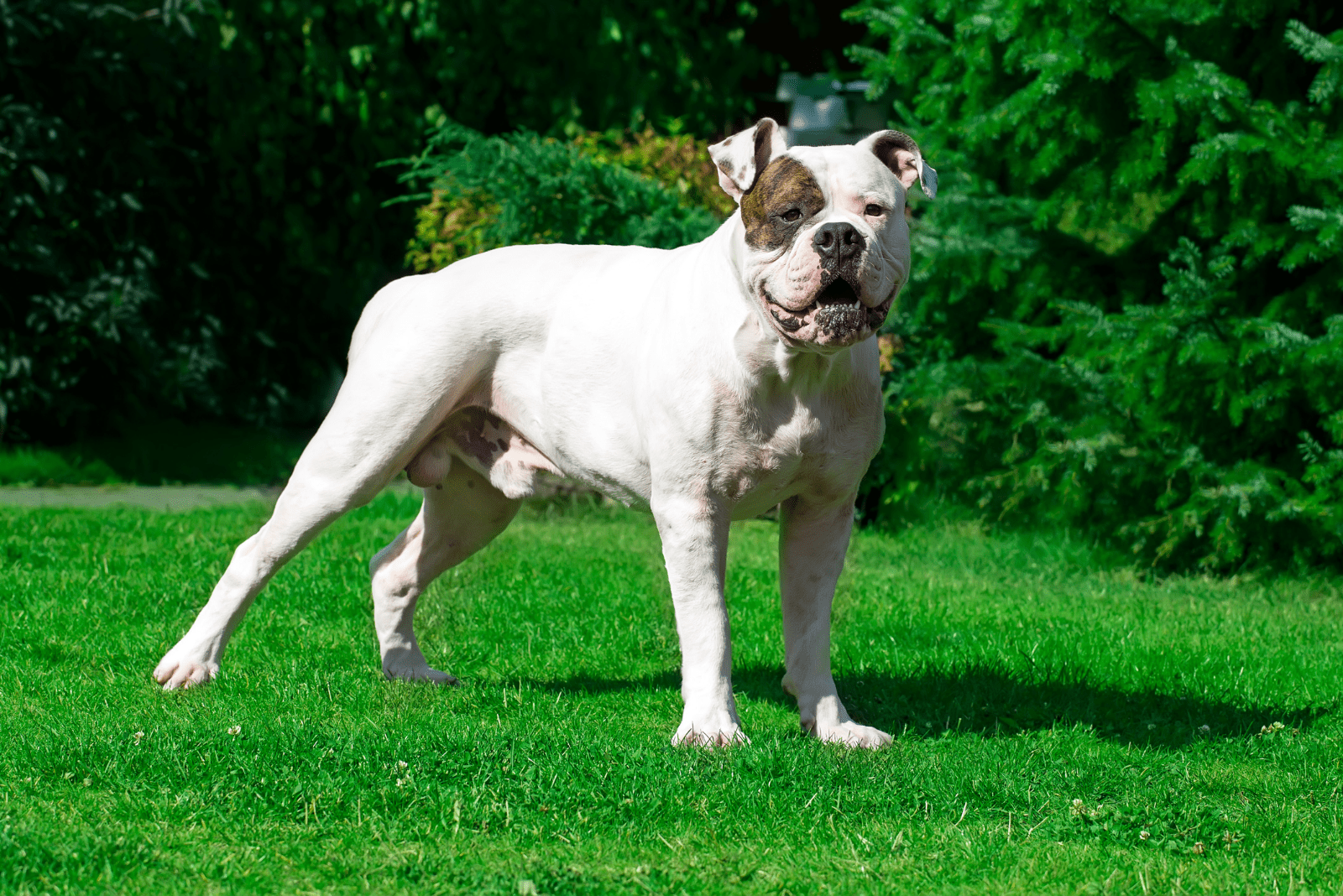Unlike the English Bulldog, the American variant is a lot more athletic and has its roots in the working line of dogs. Not only does it require more exercise, but also a high-quality diet to fuel the muscular body.
Improvising the diet plan for an American Bulldog is not advisable as they have very particular needs in terms of dog food. For this reason, I did the research and created this American Bulldog feeding chart to give your dog a head start.
We will talk about types of food, nutritional value, portioning, healthy weight, and much more, so do not skip any parts. Food is the main pillar of a healthy and long-lived dog.
American Bulldog Feeding Chart
There are several types of American Bulldogs, and they all vary in size. For this reason, the dog weight in the chart will have a large minimum and maximum. Another reason for this is the size difference between male and female American Bulldogs.
Because it is a very muscular dog breed, the males are noticeably larger than the females. On average, an adult male will weigh from seventy-five to hundred and twenty-five pounds, and the females will weigh between sixty and ninety pounds.
[table id=679 /]
Chart Breakdown
An American Bulldog has bursts of growth that make it an early bloomer. At eighteen months of age, they are already considered fully grown in terms of height, but it is possible they will put on more muscle until they are two years old.
Large dogs that have different-sized parents can range from medium-large to large and require a lot of protein in their diet. So, an American Bulldog puppy will need more caloric food than an English Bulldog.
For proper development and continuous growth, the Association of American Feed Control Officials recommends at least twenty-two percent dry matter protein for growth and eighteen percent for maintaining an adult dog’s weight.
This is especially important during the period between six and twelve months when at least eighty percent of their adult body weight is already there. Weighing your American Bulldog is crucial in fine-tuning the amount of food per meal.
High-quality kibble is a great choice for puppies because it provides the right amount of protein, fat, carbohydrates, vitamins, and minerals without much calculation on your side. Wet foods can be useful too, but only if the ingredients are well balanced.
Meal frequency decreases with an increase in amount. Every individual dog requires adjustments, and the chart is supposed to give you an estimate of how much and how often. If your dog is very active, then you might want to add some treats during the day.
Always promote frequent physical activity over lowering the amount of food. Dog bodies are astonishingly efficient at spending those extra calories, especially with the amount of muscle American Bulldogs have.
Dietary Considerations For My American Bulldog Puppy
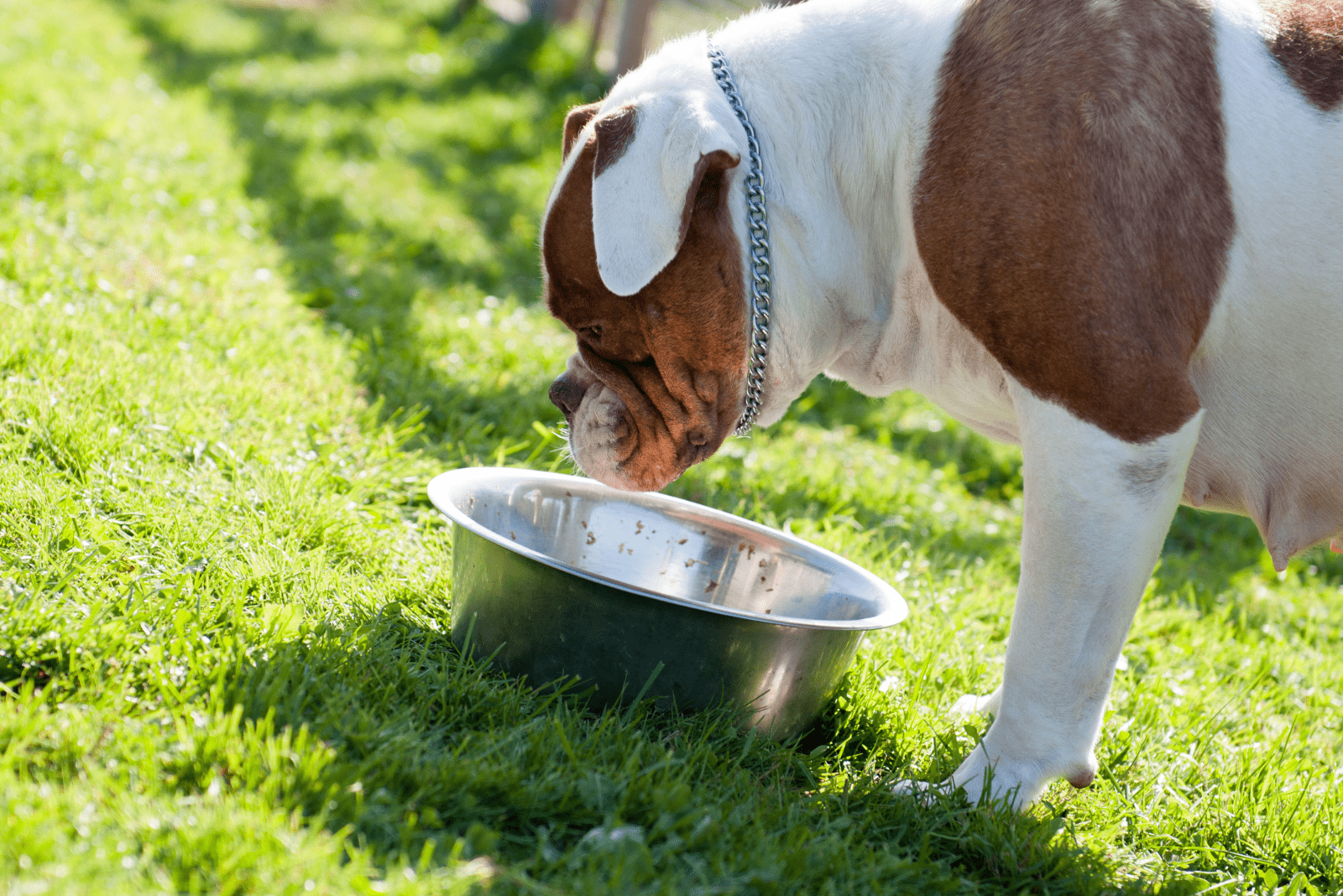
Puppies that grow at a fast pace require more protein and fat than adult dogs. Up until eighteen months of age, you should feed your puppy the full twenty-two percent of protein from dry matter and around ten to twelve percent fat per meal.
Make sure the food you are feeding to your puppy has adequate amounts of vitamins A, B-complex, D, E, K, and choline. Minerals such as phosphorus and calcium play a key role in nutrient synthesis and normal hormonal function, so read the list of ingredients and nutrients on the food label.
Calcium, vitamins B-complex and choline are all vital in normal bone formation and strength. Large dogs with a lot of muscle require dense bones to be able to support the pressure of the entire body.
An American Bulldog puppy grows so rapidly that the bone density can often fall behind weight gain. Regularly weigh your dog to see if its weight matches that from the chart, and feed accordingly.
Things To Avoid And Puppy Portioning
Never feed your puppy a raw diet. Puppies’ stomachs have to reach maturity to be able to process the raw nutrients without causing harm to the body. Once your American Bulldog reaches eighteen months, you can slowly start switching to a raw diet if you set your mind to it.
Do not feed puppies fewer than two meals a day. It is always better to feed them three or four smaller meals to avoid bloat or Gastric dilatation and volvulus (GDV). Although it is rarer in young dogs, it is still a risk you would want to avoid.
Also, make sure the food is small enough for the dog to be able to chew it properly without just swallowing. Many high-quality dog food brands have puppy food, which contains all the ingredients for a balanced diet and is appropriate in terms of size.
If necessary, you can create puppy mush to help your puppy’s digestion. Consult the veterinarian before adding dairy or third-party liquids to the meal.
What Types Of Diets Are Good For My American Bulldog?
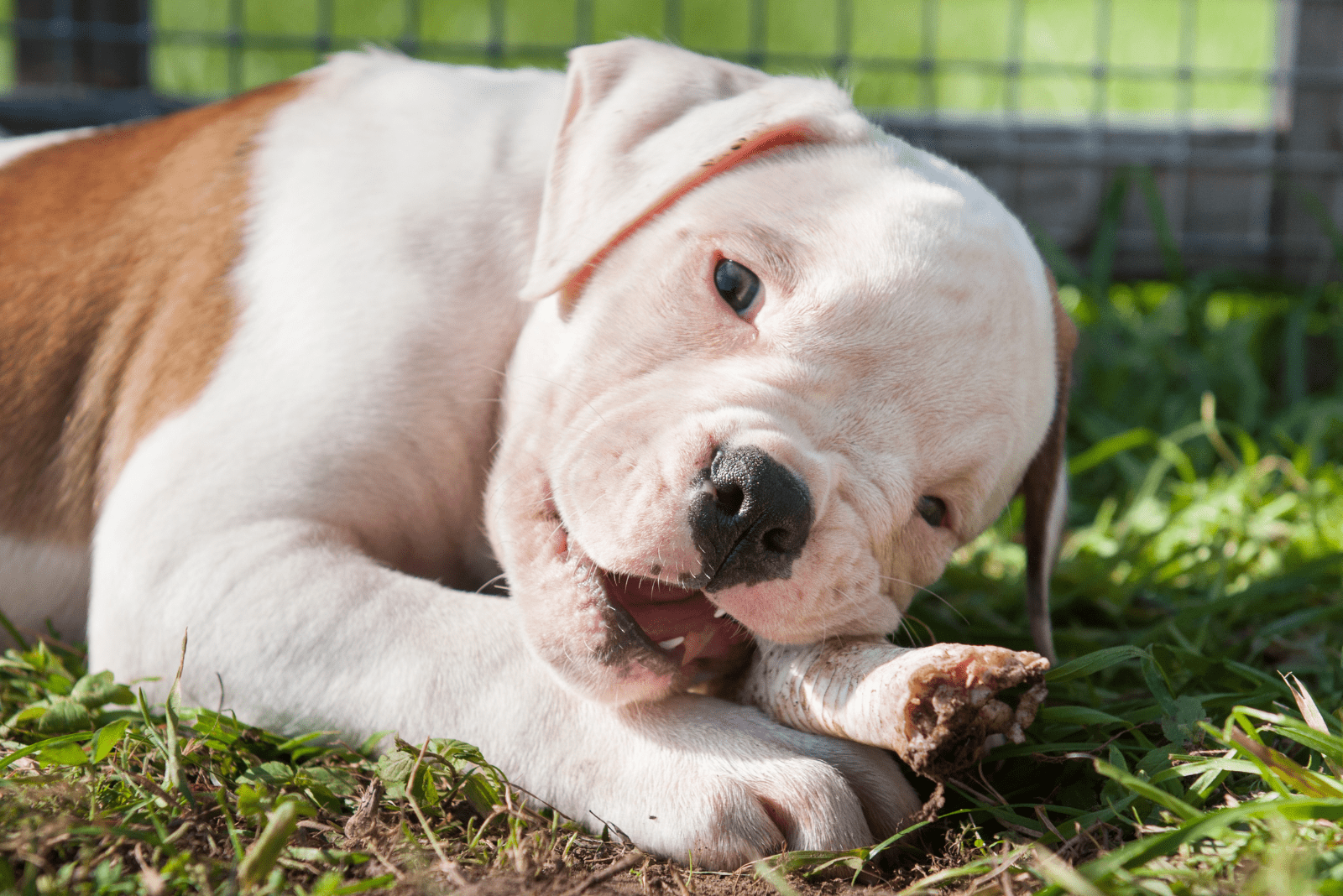
Creating new diet plans and regimes seems to be a trend that is ramping up. There are a number of diets that have “different” approaches to dog feeding, and I will give you a rundown of all.
Some are well-received by the animal medical community, while others receive negative feedback. Dog owners choose their dogs’ diets based on what they are most comfortable with. Kibble and wet food are convenient, and busy people find them an excellent choice.
Those with more time to spend with their dog prefer a home-cooked (fresh) or raw diet. Every diet has pros and cons, so allow me to help you decide which one is the right fit for you and your dog.
Kibble And Wet Food Diets
I am sure you have read about additives whenever kibble or wet food is mentioned. Indeed, eliminating fillers from large-scale kibble and wet food production would be a very bad business decision.
Storing this type of food is great too. It has a lengthy shelf-life and can be stored virtually anywhere. The packaging always has detailed information about what ingredients are in the food.
Portioning is simple with kibble and wet food — you can measure the correct amount by calculating cups of food. The standard unit of measure is an eight-ounce cup.
All is good if the protein content is first in line, followed by fat, carbohydrates, vitamins, and minerals. The long shelf-life is achieved by adding preservatives. The two types include natural and artificial preservatives.
Artificial preservatives are not a death sentence for your dog, but dog owners are definitely in the right wanting to avoid them in their dog’s food. Overall health and lifespan will be improved if you opt for wet food because canning mostly includes natural preservatives.
Dry food will probably be your best choice for an American Bulldog puppy, and wet food once it reaches sixteen or eighteen months of age. Wet foods can cause diarrhea in puppies, so best to avoid them at the beginning.
Water is even more essential than food, so have plenty of fresh water at your dog’s disposal. Canned food does not have enough water content for your growing puppy or adult dog.
A Home-Cooked Diet For Your Dog’s Well-Being
Fresh diets are amazing for your canine family member. Animal meat, organs, vegetables, and bones are all ingredients of a comprehensive meal. Many dog owners claim their dog had a longer life and better overall health on a fresh diet.
Unfortunately, there is no scientific proof confirming a drastically better quality of life in dogs that are on a fresh diet. A large number of breeders and performance dog owners are adamant that their dogs have a higher level of activity and better coats when on a fresh or raw diet.
The higher level of activity is plausible since the food will be digested more quickly (the nutrients in this form are easier to absorb), and poops will be smaller due to the greater concentration of easily absorbable ingredients.
By now, you must have realized that it is actually a slightly healthier diet than kibble or canned food, but there are some downsides. You first have to find certified and high-quality raw ingredients. Then, you have to cook and portion them fittingly.
This is time-consuming and takes a while before you establish a routine that will create an efficient process. Consider your budget as well because a fresh diet does not come cheap.
Raw Diets Are Controversial, But…
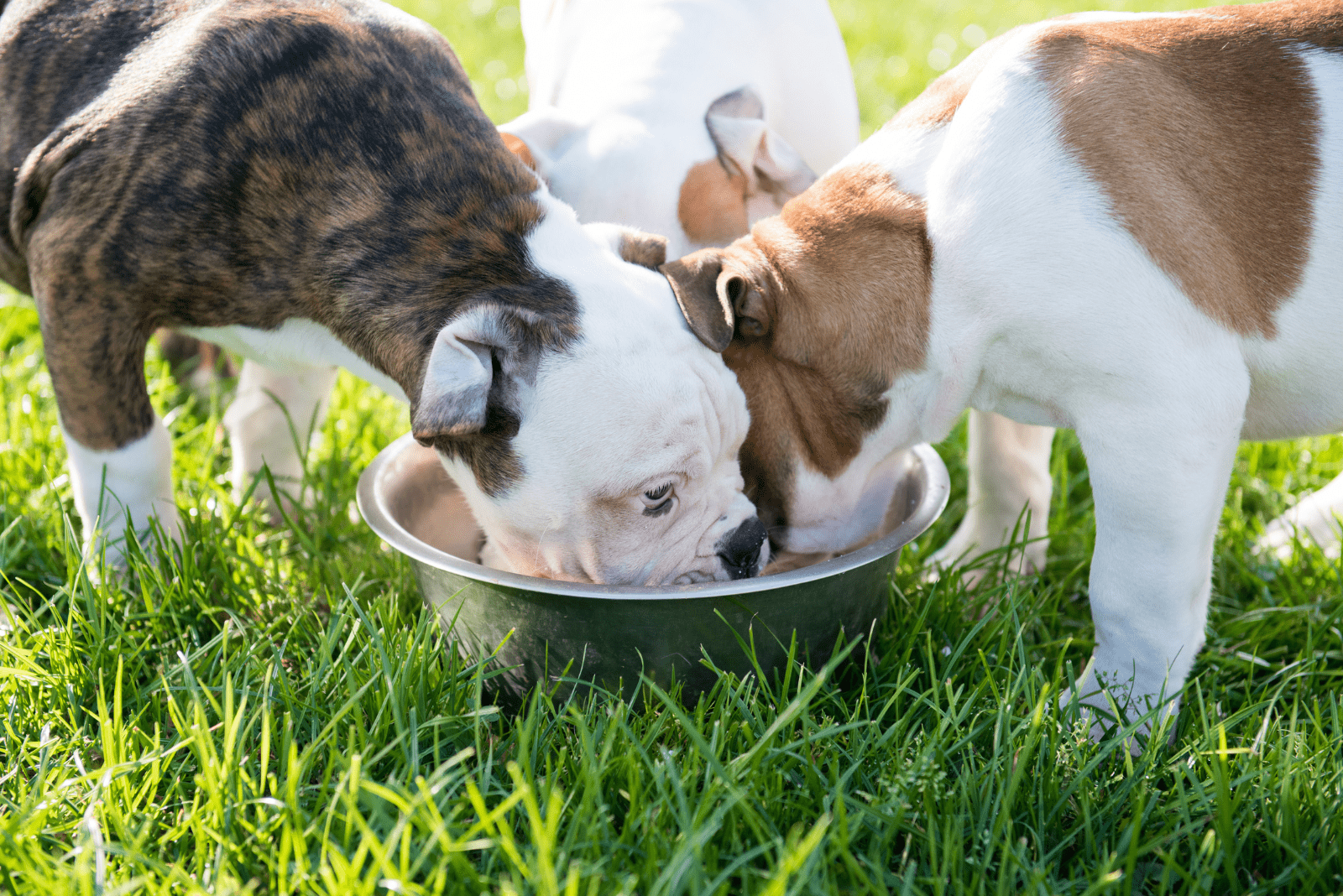
Puppies should not be on raw diets. Their developing digestive system is not able to process the nutrients properly. Once your American Bulldog reaches one and a half years of age, you can start introducing raw food.
Raw food diets are similar to fresh food diets, with one big difference — the ingredients stay raw. Veterinarians and animal medical associations agree that a fresh diet is superior in terms of nutritional value and health reasons.
Prepackaged raw food meals are available for you to buy, but it is important to look for certificates that guarantee the meat passed all health checks with flying colors.
This simplifies portioning and saves you some time, but every dog should have a diet tailored to its individual needs.
Unlike French Bulldogs, the American counterpart is much more athletic and with fewer health problems. Purely on their role as working dogs and muscularity, owners often deem raw diets mandatory.
Be Cautious Of Bacteria
Whether we are talking about a Husky, American Bulldog, Pitbull, or any other breed, the type of diet does not matter as long as it contains all the required ingredients for a healthy life. There is no such thing as a “healthiest” diet.
Still, raw food has a major downside — bacterial, viral, or parasite infections. The meat can be certified and successfully pass health checks but still contain traces of pathogens such as salmonella or listeria.
Just handling the raw food can spread germs all over the house, putting your family at risk of infection too. This is why cooking your dog’s food is always safer than feeding it raw meat.
Certain grains like oat are tough to digest in a raw form, and the dog will benefit from them being cooked. The same goes for vegetables and fruit, though fruit is not a dietary requirement for dogs.
Fruit such as plantains, fig newtons, prunes, durian, and guava are all safe for your dog if you want to add some new flavor to the diet. Keep in mind that your dog could be allergic to certain foods, so consult a vet before including them.
Science Diet Is Not Really A Diet
Companies love to market stuff with promises that never come true. You would think a science diet includes something based on scientific breakthroughs, but I am afraid it is yet another dry/wet food line of products.
Hill’s has been around for a while and, along with Royal Canin, owns a large share of the dog food market. While the “Science diet” food is not bad itself, it is no different from other products in the same category.
Putting the word science in a product name does not make it better. It simply caters to dog owners’ desire to provide the best possible diet for their canines. There have been several recalls of this product line due to toxic quantities of vitamin D in the food.
I would not consider products that have been recalled as the main diet for my dog. From a purely logical point of view, buying any product that has been recalled would be a hard pass for me. High-quality food does not have to come from a corporate giant.
Diet-Induced Health Problems In American Bulldogs
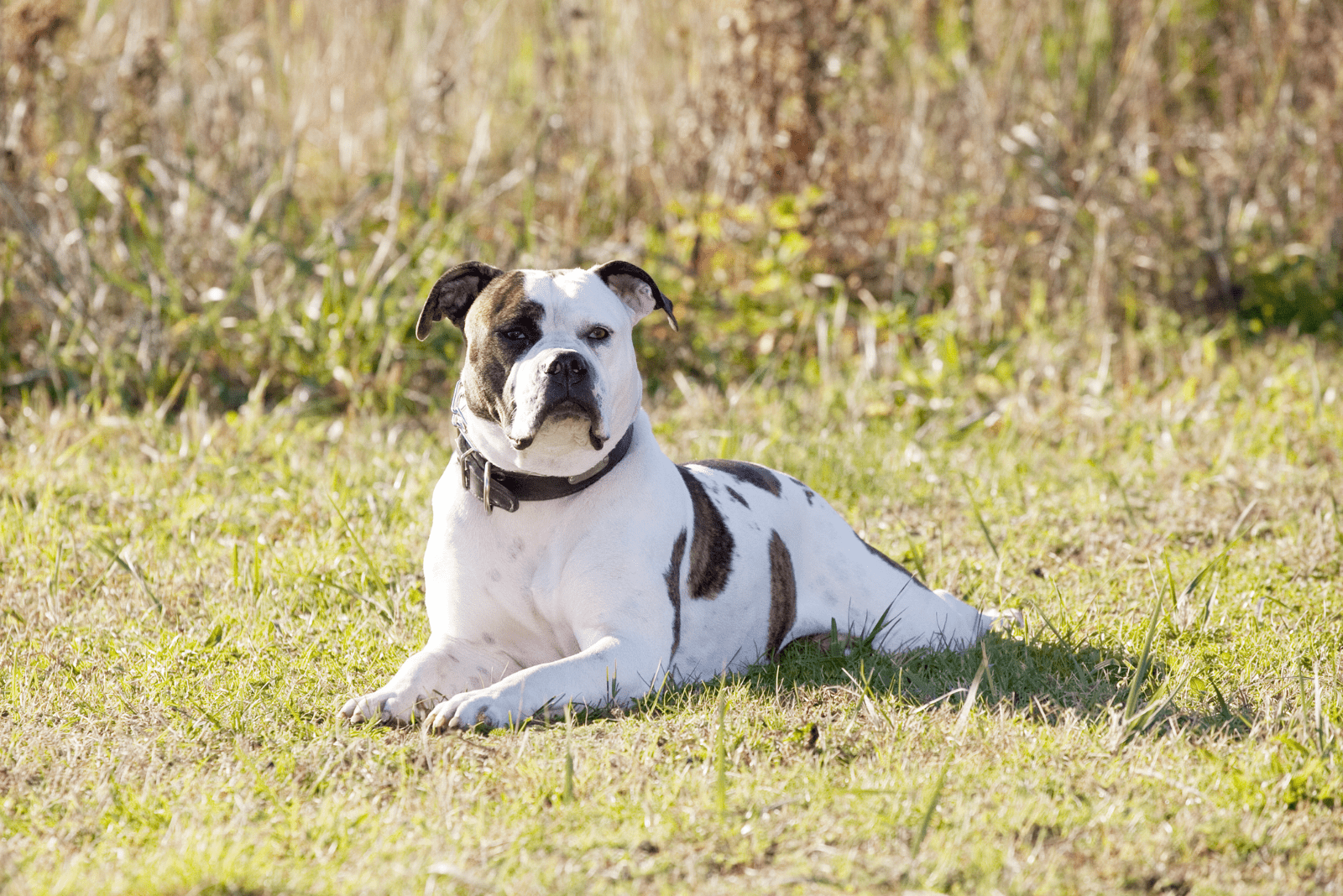
Though American Bulldogs are brachycephalic, the problem is slightly smaller than in the OG English Bulldog. This means that your American Bulldog has a higher chance of having problems with its airways and allergens that can be inhaled.
Unfortunately, this is not the only health problem that likes a good boy or girl. Obesity caused by overfeeding, hip dysplasia, and cherry eye are some of the most common health issues that plague Bulldogs. Let us quickly go through them and be done with the bad stuff.
Obesity
American Bulldogs grow fast. If you like to rest at the end of a hard day’s work, you will enjoy your dog’s company on the couch. You will break out the best snacks the snack drawer has to offer and perhaps share some of them with your dog.
Even if you feed your dog only the best foods on any kind of diet, there is a possibility of overfeeding it. One of the most common causes of overfeeding is treats. Most owners do not count them in the daily calories total and unwillingly teach their dogs some bad eating habits.
Oftentimes, owners will want their dogs to grow faster or bigger than they naturally can, so they feed them so much meat that the dog becomes obese in just a few months. A diet should be balanced for the best result.
Low-quality foods with lots of fillers that include starch and complex carbohydrates can cause sudden weight gain. You will know your dog is overweight if its size increases, but the musculation is less visible.
Hip Dysplasia
Everybody and their dog knows about this condition. It occurs when the ball of the femur does not sit properly in the socket joint of the hip, and the cartilage that lines the bone starts degrading until it is completely gone.
Once that happens, the bone tissue becomes damaged with every move, and the dog starts experiencing pain and difficulty moving. If caught early, it can be treated with NSAIDs, but more severe cases require complex surgery or hip replacement.
Hip dysplasia can be easily caused by obesity because the excess weight that is put on the dog’s joints has the ability to change the anatomy of the moving mechanism of the hip.
Cherry Eye
This is a congenital condition that affects Bulldog breeds more than others. It is characterized by a protruded third eyelid that gets inflamed due to irregular eye anatomy.
Dogs affected by cherry eye or protruding eyelid often have something that resembles a red (cherry) mass on the inside corner of the eye. While the condition does not cause pain, it can be exacerbated by the dog’s incessant pawing.
If not treated early, it can cause damage to the cornea or reduced production of the fluid that “greases” the eyes (tears). Routine surgery is the most common treatment, with a rather easy and short recovery.
Long exposure to foods your American Bulldog is allergic to can cause cherry eye. It is important to have the vet test your puppy for food allergies if you notice any symptoms, such as refusing to eat certain foods, pawing after eating, or watery/dry eyes.
Conclusion
You will certainly go through a trial-and-error period while figuring out your dog’s diet. If you are a first-time dog owner, this American Bulldog feeding chart will be immensely helpful in getting you started.
However, it is only a guide, and you should adapt it to your dog’s dietary needs. There is no one size fits all approach to dog feeding, so some effort in ironing out the details will be required.
When choosing the right food, consider the quality of the ingredients, the dog’s activity level, and your lifestyle. All these elements combined have an impact on the lifespan and overall health of your American Bulldog.
Do not forget to provide ample exercise for your canine friend, and consult a vet if you notice a change in behavior when switching between diets. One can never be too careful.
Read Next:
• Johnson American Bulldog Breeders In The United States
